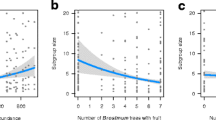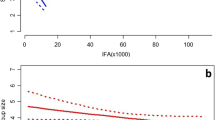Abstract
Hurricanes can bring about dramatic changes to ecosystems and adversely affect animals that live in them. We monitored behavioral responses in wild spider monkeys (Ateles geoffroyi yucatanensis) in the aftermath of two hurricanes (Emily and Wilma) that moved through the Yucatan peninsula in 2005. We predicted that the monkeys would shift their diets depending on relative food availability and experience a change in the distribution of activity patterns. Because spider monkeys’ social organization is characterized by a high degree of fission–fusion dynamics, we predicted they would form smaller subgroups subsequent to the hurricanes to mitigate competition over limited food resources. We compared their responses in the immediate aftermath of Hurricane Emily and across the dry seasons before and after both hurricanes, to control for seasonal changes, by examining their activity budgets, foods consumed, and subgrouping dynamics. In the immediate aftermath of Hurricane Emily spider monkeys spent less time moving and more time feeding on leaves than before the hurricane and they were in smaller subgroups. In the dry season after both hurricanes the monkeys spent more time resting and less time moving than before the hurricanes, and leaves replaced fruit as their primary food resource. They fused into larger subgroups less often and had smaller subgroup sizes in the dry season after than before the hurricanes. Thus, the high degree of fission–fusion dynamics of spider monkeys was instrumental in affording the behavioral flexibility critical to cope with the negative post-hurricane consequences.




Similar content being viewed by others
References
Asensio, N., Korstjens, A. H., Schaffner, C. M., & Aureli, F. (2008). Intragroup aggression, fission-fusion dynamics and feeding competition in spider monkeys. Behaviour, 145, 983–1001.
Asensio, N., Korstjens, A. H., & Aureli, F. (2009). Fissioning minimizes ranging costs in spider monkeys: a multiple-level approach. Behavioral Ecology & Sociobiology, 63, 649–659.
Aureli, F., & Schaffner, C. M. (2008). Social structure, social relationships and social interactions. In C. Campbell (Ed.), Spider monkeys: Behavior ecology and evolution of the genus Ateles (pp. 236–265). Cambridge: Cambridge University Press.
Aureli, F., Schaffner, C. M., Boesch, C., Bearder, S. K., Call, J., Chapman, C. A., et al. (2008). Fission-fusion dynamics: new research frameworks. Current Anthropology, 49, 627–654.
Behie, A. M., & Pavelka, M. S. M. (2005). The short-term effects of a hurricane on the diet and activity of black howlers (Alouatta pigra) in Monkey River, Belize. Folia Primatologica, 76, 1–9.
Behie, A. M., & Pavelka, M. S. M. (in press). Fruit as a key factor in howler population density: conservation implications. In M. Kowalewski, P. Garber, L. Cortés-Ortiz, B. Urbani, & D. Youlatos (Eds.), Howler monkeys: Examining the biology, adaptive radiation, and behavioral ecology of the most widely distributed genus of Neotropical primate. Developments in primatology: Progress and prospects. New York: Springer.
Berenstain, L. (1986). Responses of long-tailed macaques to drought and fire in eastern Borneo: a preliminary report. Biotropica, 18, 257–262.
Bonilla-Moheno, M. (in press). Vegetation effects and short-term recovery from two consecutive hurricanes in the Yucatan Peninsula. Caribbean Journal of Science.
Brokaw, N. V. L., & Walker, L. R. (1991). Summary of the effects of Caribbean hurricanes on vegetation. Biotropica, 23, 442–447.
Campbell, C. J., Aureli, F., Chapman, C. A., Ramos-Fernandez, G., Matthews, K., Russo, S. E., et al. (2005). Terrestrial behaviour of Ateles spp. International Journal of Primatology, 26, 1039–1051.
Chapman, C. A., Wrangham, R. W., & Chapman, L. J. (1995). Ecological constraints on group size: an analysis of spider monkey and chimpanzee subgroups. Behavioural Ecology & Sociobiology, 36, 59–70.
Chaves, Ó., Stoner, K., & Arroyo-Rodríguez, V. (2011). Seasonal differences in activity patterns of spider monkeys living in continuous and fragmented forests in southern Mexico. International Journal of Primatology, 32, 960–973.
Chaves, Ó., Stoner, K., & Arroyo-Rodríguez, V. (2012). Differences in diet between spider monkey groups living in forest fragments and continuous forest in Mexico. Biotropica, 44, 105–113.
Decker, B. S. (1994). Effects of habitat disturbance on the behavioral ecology and demographics of the Tana River red colobus (Colobus badius refomitratus). International Journal of Primatology, 15, 703–737.
Di Fiore, A., Link, A., & Dew, J. L. (2008). Diets of wild spider monkeys. In C. Campbell (Ed.), Spider monkeys: Behavior ecology and evolution of the genus Ateles (pp. 81–137). Cambridge: Cambridge University Press.
Di Fiore, A., Link, A., & Campbell, C. J. (2011). The Atelines: Behavior and socioecological diversity in a New World monkey radiation. In C. J. Campbell, A. F. Fuentes, K. C. MacKinnon, R. Stumpf, & S. Bearder (Eds.), Primates in perspective (pp. 155–188). Oxford: Oxford University Press.
Dittus, W. P. J. (1985). The influence of leaf-monkeys on their feeding trees in a cyclone disturbed environment. Biotropica, 17, 100–106.
Dittus, W. P. J. (1988). Group fission among wild toque macaques as a consequence of female resource competition and environmental stress. Animal Behaviour, 36, 1626–1645.
Fernandez, D. S., & Fletcher, N. (1991). Changes in light availability following hurricane Hugo in subtropical montane forest in Puerto Rico. Biotropica, 23, 393–399.
Fleming, T. H., & Murray, K. L. (2009). Population and genetic consequences of hurricanes for three species of West Indian Phyllostomid bats. Biotropica, 41, 250–256.
Gannon, M. R., & Willig, M. R. (1994). The effects of hurricane Hugo on bats of the Luquillo experimental forest of Puerto Rico. Biotropica, 23, 320–331.
González-Zamora, A., Arroyo-Rodríguez, V., Chaves, Ó., Sánchez-López, S., Stoner, K., & Riba-Hernández, P. (2009). Diet of spider monkeys (Ateles geoffroyi) in Mesoamerica: current knowledge and future directions. American Journal of Primatology, 71, 8–20.
Holm, S. (1979). A simple sequentially rejective multiple test procedure. Scandanavian Journal of Statistics, 6, 65–70.
Ineich, I. (2010). How habitat disturbance benefits geckos: conservation implications. Comptes Rendus Biologies, 333, 76–82.
Korstjens, A. H., Lehman, J., & Dunbar, R. I. M. (2010). Resting time as an ecological constraint on primate biogeography. Animal Behaviour, 79, 361–374.
Kummer, H. (1971). Primate societies: Group techniques of ecological adaptation. Chicago: Aldine.
Martin, P., & Bateson, P. (2007). Measuring behaviour: An introductory guide (3rd ed.). Cambridge: Cambridge University Press.
Milton, K. (1981). Food choice and digestive strategies of two sympatric primate species. American Naturalist, 117, 496–505.
Pavelka, M. S. M., & Behie, A. M. (2005). The effect of hurricane Iris on the food supply of black howlers (Alouatta pigra) in Southern Belize. Biotropica, 37, 102–108.
Pavelka, M. S. M., & Behie, A. M. (2008). Reduction and recovery of a black howler monkey population in response to a major hurricane. Primate Eye, 96, 88.
Pavelka, M. S. M., Brusselers, O. T., Nowak, D., & Behie, A. M. (2003). Population reduction and social disorganization in Alouatta pigra following a hurricane. International Journal of Primatology, 24, 1037–1055.
Pavelka, M. S. M., McGoogan, K. C., & Steffens, T. S. (2007). Population size and characteristics of Alouatta pigra before and after a major hurricane. International Journal of Primatology, 28, 919–929.
Ramos-Fernández, G. (2005). Vocal communication in a fission-fusion society: do spider monkeys stay in touch with close associates? International Journal of Primatology, 26, 1077–1092.
Ramos-Fernández, G., & Ayala-Orozco, B. (2003). Population size and habitat use of spider monkeys at Punta Laguna, México. In: L. K. Marsh (Ed.), Primates in Fragments: Ecology and Conservation, (pp.191–209). New York: Kluwer Academic/Plenum Press.
Ramos-Fernández, G., Vick, L. G., Aureli, F., Schaffner, C. M., & Taub, D. M. (2003). Conservation status of the spider monkeys in the Otoch Ma'ax Yetel Kooh protected area. Neotropical Primates, 11, 155–158.
Ratsimbazafy, J. (2006). Diet composition, foraging, and feeding behavior in relation to habitat disturbance: Implications for the adaptability of ruffed lemurs (Varecia v. editorium) in Manombo forest, Madagascar. In L. Gould & M. L. Sauther (Eds.), Lemurs: Ecology and adaptation (pp. 403–422). New York: Springer.
Russo, S. E., Campbell, C. J., Dew, L., Stevenson, P. R., & Suarez, S. A. (2005). A multi-forest comparison of dietary preferences and seed dispersal by Ateles spp. International Journal of Primatology, 26, 1017–1037.
Shimooka, Y. (2003). Seasonal variation in associationtion patterns of wild spider monkeys (Ateles belzebuth belzebuth) at La Macarena, Colombia. Primates, 44, 83–93.
Symington, M. M. (1990). Fission-fusion social organization in Ateles and Pan. International Journal of Primatology, 11, 47–61.
Tossas, A. G. (2006). Effects of hurricane Georges on the resident avifauna of Maricao State Forest, Puerto Rico. Carribean Journal of Science, 42, 81–87.
Tutin, C. E. G., Ham, R. M., White, L. J. T., & Harrison, M. J. S. (1997). The primate community of the Lope Reserve, Gabon: diets, responses to fruit scarcity and effects on biomass. American Journal of Primatology, 42, 1–24.
Vick, L. G. (2008). Immaturity in spider monkeys: A risky business. In C. Campbell (Ed.), Spider monkeys: Behavior ecology and evolution of the genus Ateles (pp. 288–328). Cambridge: Cambridge University Press.
Waide, R. B. (1991). Summary of the response of animal populations to hurricanes in the Caribbean. Biotropica, 3, 508–512.
Wallace, R. B. (2005). Seasonal variations in diet and foraging behavior of Ateles chamek in southern Amazonian tropical forest. International Journal of Primatology, 26, 1053–1075.
Wallace, R. B. (2008). Towing the party line: territoriality, risky boundaries and male group size in spider monkey fission-fusion societies. American Journal of Primatology, 70, 271–281.
Wiley, J., & Wunderle, J. M. (1993). The effects of hurricanes on birds with special reference to Caribbean Islands. Bird Conservation International, 3, 319–349.
Willig, M. R., & Camilo, G. R. (1991). The effect of hurricane Hugo on six invertebrate species in the Luquillo experimental forest of Puerto Rico. Biotropica, 23, 455–461.
Wingfield, J. C. (2003). Control of behavioural strategies for capricious environments. Animal Behaviour, 66, 807–816.
Zimmerman, J. K. L., & Covich, A. P. (2007). Damage and recovery of riparian sierra palms after hurricane Georges: influence of topography and biotic characteristics. Biotropica, 39, 43–49.
Acknowledgments
We thank Pronatura Peninsula de Yucatan for logistical support and the coordination of the permission to conduct our research. We also thank Eulogio Canul-Aban, Macedonio Canul-Chan, Augusto Canul-Aban, Juan Canul-Chan, Norberto Asensio, and Nicola Forshaw for valuable assistance in the field. We thank the community of Punta Laguna for their support of the long-term spider monkey project. We also thank two anonymous reviewers for their supportive and constructive comments. We thank The British Academy, The Wenner-Gren Foundation, CONACYT J51278, The University of Chester, Instituto Politécnico Nacional, William Peace University, and The North of England Zoological Society for support of the long-term project. We also thank the Santander Universities Scheme and the Gladstone Bursary scheme of The University of Chester for support to L. Rebecchini.
Author information
Authors and Affiliations
Corresponding author
Rights and permissions
About this article
Cite this article
Schaffner, C.M., Rebecchini, L., Ramos-Fernandez, G. et al. Spider Monkeys (Ateles geoffroyi yucatenensis) Cope with the Negative Consequences of Hurricanes Through Changes in Diet, Activity Budget, and Fission–Fusion Dynamics. Int J Primatol 33, 922–936 (2012). https://doi.org/10.1007/s10764-012-9621-4
Received:
Accepted:
Published:
Issue Date:
DOI: https://doi.org/10.1007/s10764-012-9621-4




